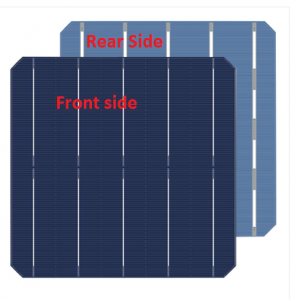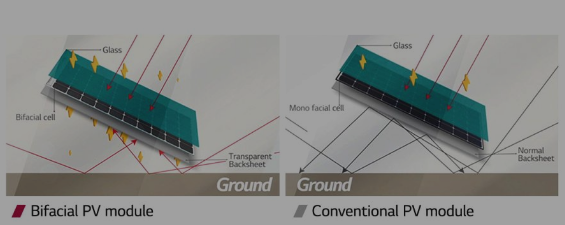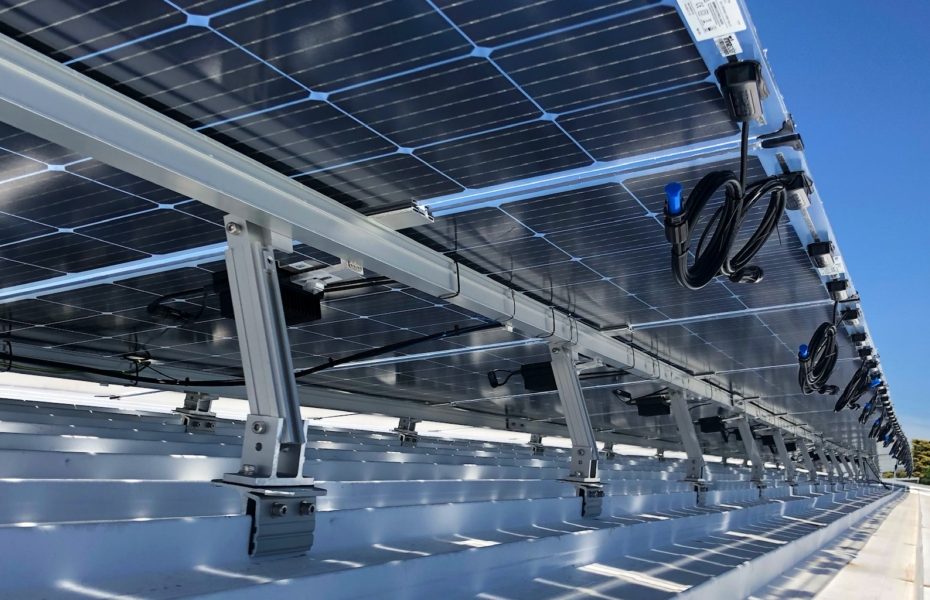A new generation of bifacial PV Modules capable of capturing light reflected off the ground onto the back side of the PV modules may be a game changer as well as new face of PV industry. Lets us demystify the new buzzword of solar industry in a simple way! – The Bifacial PV Modules
Bifacial solar modules offer many advantages over traditional solar modules. Power can be produced from both sides of a bifacial module, increasing total energy generation. Bifacial modules expose both the front and backside of the solar cells. When bifacial modules are installed on a highly reflective surface (like a white TPO roof or on the ground with light-colored stones), some bifacial module manufacturers claim up to a 30% increase in generation just from the extra power generated from the rear. Typically, bifacial panels yielded 11-15% more energy than standard solar panels in a tilted, ground-mounted solar installation. More impressively, a system using bifacial panels paired with solar trackers yielded 27-30 % more solar energy than a similarly sized system using traditional panels.
Bifacial modules come in many designs. Some are framed while others are frameless. Some are dual-glass, and others use clear back sheets. Bifacial panels are usually made from mono crystalline cells, but polycrystalline designs exist as well. The one thing that is constant is that power is produced from both sides. There are frameless, dual-glass modules that expose the backside of cells but are not bifacial. True bifacial PV modules have contacts/bus bars on both the front and back sides of their cells used to make the same.

Mono-facial /Conventional Solar Cell-Used in Mono facial /Conventional module

Note – Bi-facial cells may be P-type or N-type
Bifacial Modules are the perfect application of half cut cells. The gain due to the bifaciality mainly reflects in currents, which also increase the losses. Thus half configuration is better for interconnecting bifacial cells in order to compensate for such losses.
Durability
These are often more durable because both sides are UV resistant, and potential-induced degradation (PID) concerns are reduced when the bifacial module is frame-less. Balance of system (BOS) costs are also reduced when more power can be generated from bifacial modules in a smaller array footprint.


The design of mounting systems for bifacial solar panels is also different than traditional solutions. In order to capture the most energy, bifacial panels need the least amount of shaded space possible on the front and back of their surfaces.
Fabrication Aspects
A bifacial module is not too different from conventional module but there are few changes. One is must, the others are optional to enhance performance. Obviously switching to a transparent back cover is required, otherwise cells cannot absorb sunlight on the rear side. In addition to changing junction box design, opting for alternative encapsulation material and implementing more suitable interconnection approaches helps in maximizing the benefits from bifacial architecture.
Back Side
First and foremost bifacial modules need to replace opaque back sheet. The choice is between transparent back sheet and glass.
Interconnection
As per the core interconnection process of a bifacial module, only a slight optimization is required, especially regarding heating and cooling of the cells. That’s because bifacial cells without Al-BSF behave differently during thermal treatment.
Junction box
Though not critical, replacement or moving the junction box is recommended so that it doesn’t cover any cells on rear side of the bifacial PV module. New junction box designs that can be placed at the corners are available commercially from several vendors.
Testing Module and Standardization
One of the main challenge with Bifacial module is how to test and finally how to label the module. Since there are no standards, every company follows a different approach. Some companies are flashing the module from front side with an intensity of 1.1 suns and covering the module from rear side. Some companies measure both sides of the module at STC by covering the other sides with non reflective sheets and reporting both values in the datasheet. The customer can decide what kind of power he gets. Some companies just measure the front side at STC. However, IEC Standard TS 60904-1-2:2019 describes procedures for the measurement of the current-voltage (I-V) characteristics of bifacial photovoltaic devices in natural or simulated sunlight. It is applicable to single PV cells, sub-assemblies of such cells or entire PV modules.
Bifacial PV Module Mounting Height
Nearer a bifacial PV module array to the ground or a roof surface, lesser the chances that reflective light will reach to the back surface of the PV module array. A significant bifacial power boost has been possible, however, with a relatively modest height increase itself. The bifacial PV modules are appropriate mostly for ground-mounted utility scale applications, given that the leading edge of these arrays is usually from 18 inches to 36 inches above the ground.
Almost all major Tier -1 companies like Longi, JA Solar, Jinko, Trina, First Solar, Canadian Solar and our own Adani Solar have started manufacturing of Bifacial PV Modules in the last couple of years. We will see more and more capacities of bifacial cells and modules being added every year considering its inherent advantages, leading to lower LCOE for large scale utility projects.

It’s very good innovation. Thanks for sharing knowledgeable article. Go grow.